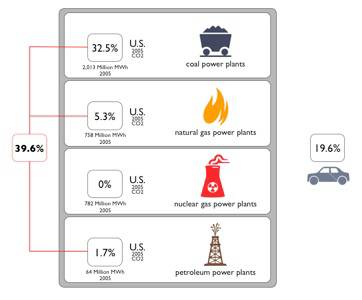ECOLEAF: Climate Change and Green House Gases

From 2004 to 2030, global carbon dioxide emissions will increase 59%, or from 26,992 to 42,880 million metric tons. By 2030, China’s output of pollutants will double and account for 26% of the world’s emissions. The sooner viable alternative fuels are developed, the sooner the United States, China, and other countries can begin adopting them. If this does not happen, the future looks grim.
U.S. ELECTRICAL ENERGY EMISSIONS

The brutal truth about coal is that—per kW of energy—it produces an average of 2.3 times more CO2 than natural gas does. Burning natural gas in a power plant emits 428 grams of CO2. Black coal emits 949 grams; lignite coal, 1,153 grams. Even if it were possible to increase the use of natural gas power plants to reduce greenhouse gases, the impact would be limited: due to increasing demand and declining availability, natural gas prices are rising faster than coal prices are, as evinced by the fact that in 2005, the average energy cost of coal in the U.S. was one-fifth of that of natural gas.
THE E.P.A. ACKNOWLEDGES GREENHOUSE GASES
The Environmental Protection Agency in April 2009 finally acknowledged carbon dioxide and several gases are apart of global warming. Throwing aside the Bush Era’s suppression of these issues President Obama has unleashed another call for the need of green.
Officially greenhouse gases include carbon dioxide, methane, hydroflourocarbons, perfluorocarbons, nitrous oxide, and sulfur hexaflouride. These acknowledged gases are very dangerous to the earth’s ecosystem and their continued infusion into the air is resulting in many dangers including sporadic heat waves, wildfires, elevated sea levels, droughts, and flooding.
The elevated status by the E.P.A. of these gases will no doubt help spur forward momentum with green energy. It will place necessary hardships on coal and other carbon emitting power plants, in addition to applying pressure to energy and auto companies to clean up their carbon addiction act.
Important Points:
1.For green energy to be a viable option, other polluting energies may require higher taxation, fees, and may have to purchase carbon credits.
2.Lisa P. Jackson is the E.P.A. Administrator
3.John P. Holdren is the science advisor to President Obama.
4.The United States produces 22% of the greenhouse gases, so in essence we are one of the world’s biggest producers. Imagine if the U.S. were liable to the planet, to other countries, to mother nature?
5.With Earth Day on April 22nd, we should seriously think about the ramifications of this acknowledgment and hope that with it comes the responsibility for change.
DIRTY ENERGY




Stay Informed
Get updates and action alerts.



back
next

Delivering Green Clarity in a Carbon-Troubled World™
Copyright © 2008 - 2010 by ECOLEAF™. All rights reserved.
Reproduction in whole or in part without permission is prohibited.
